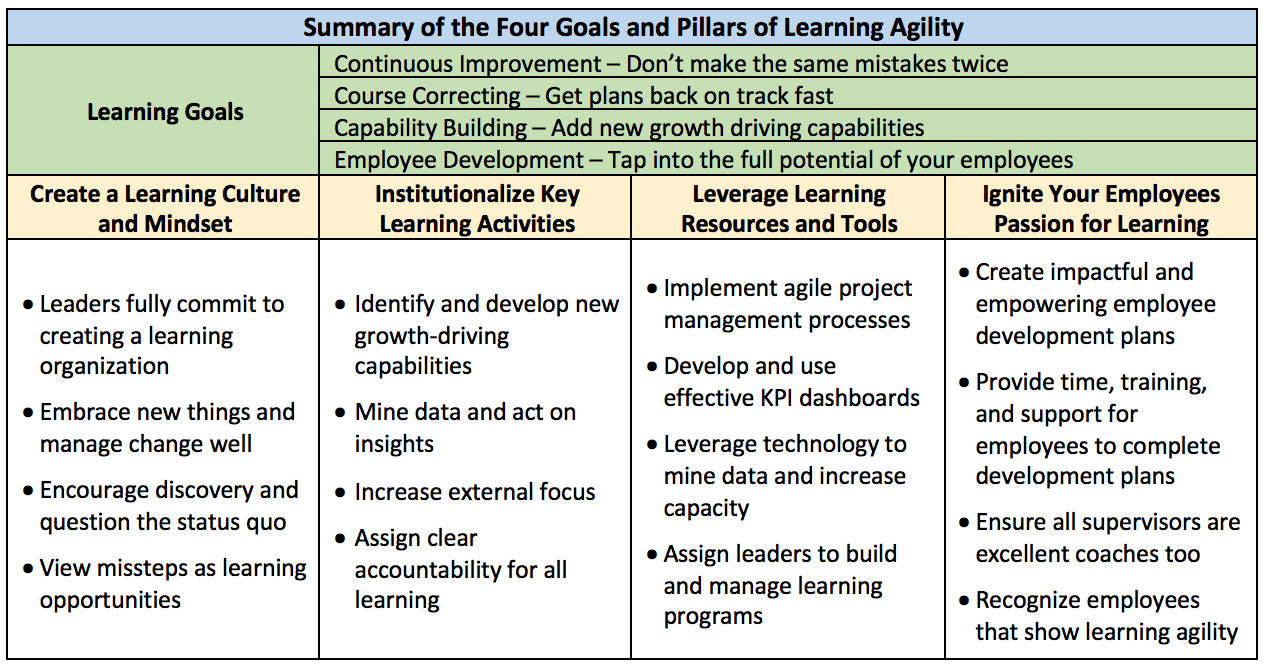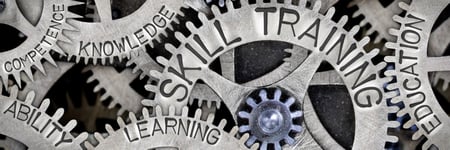CEO Blog - Advice for CEOs on growth and scaling
Maximize Your Growth Potential by Supercharging Your Learning Agility

 Imagine how much more money your company could make if you never made the same mistake twice. How much more successful would you be if you could quickly course correct every time a plan went awry? What new growth initiatives could you pursue with expanded capabilities? How much would your productivity increase if you could improve your ability to attract and retain top talent?
Imagine how much more money your company could make if you never made the same mistake twice. How much more successful would you be if you could quickly course correct every time a plan went awry? What new growth initiatives could you pursue with expanded capabilities? How much would your productivity increase if you could improve your ability to attract and retain top talent?
Supercharging your company’s learning agility can drive material improvement in each of these areas. It will also enable your company to maximize its growth potential. Learning agility is the willingness and ability to learn from experience and insight, then leverage that learning to perform better. While companies have always needed to learn and adapt to be successful, changes in technology, consumer preferences, and political and economic forces make it difficult for them to keep their growth plans on course. Access to data and emerging technology has weakened industry barriers to entry, while simultaneously leveling the playing field for competitors. In today’s complex business environment, companies that learn and adapt will be the most successful.
In the first three blogs of this four blog series on business agility, we explored how implementation of your growth plan is the most challenging part of driving growth, and how increasing company agility is necessary to keep growth plans on course. We also discussed how to build organizational agility and leverage market changes to create a competitive advantage and fuel growth, as well as how to leverage an agile mindset and approach to maximizing your marketing team’s ability to drive growth. In this chapter, we will go deeper into this growth driving capability.
How Can Companies Improve Their Learning Agility?
The first step is to identify the different types of learning you should focus on. The ones that are most beneficial to today’s companies are as follows:
- Continuous Improvement: Learning how to avoid making the same mistakes twice
- Course Correcting: Figuring out how to get plans back on track as quickly as possible
- Capability Building: Developing new company skills and competencies needed for growth
- Employee Development: Tapping into the full potential of your most important resource
Mastering the Four Pillars of Learning Agility
By following these four steps to building learning agility, you can enhance your company’s ability to learn and adapt quickly in all four of the key learning areas noted above:
1. Create a Learning Culture
A company’s culture starts with and emanates from its leaders. Thus, the leadership team must be committed to creating a learning organization. They must also be active learners themselves. Here’s a good short article published by Forbes that outlines the five dimensions of learning-agile leaders.
Creating a learning mindset begins with embracing new ideas, encouraging discovery, and questioning the status quo – so leadership modeling will be critical in this area. It’s also essential that the organization is comfortable with the changes that their learning culture will bring.
Don’t underestimate the importance of change management. Most organizations and employees struggle with this. Change is hard and can be scary, but fear of adaptation will most certainly hinder learning agility. Thus, it is critical to set up processes and tools to better manage change. I’ve found the ADKAR model particularly useful.
Some of the richest learning for organizations can be found within their mistakes and missteps. It is important to embrace business challenges as learning opportunities. If a misstep or shortcoming occurs, determine the root drivers. By understanding what went wrong, you reduce the chances of making the same mistake twice. You will also get better at anticipating problems.

2. Institutionalize Key Learning Activities
When companies develop their strategic growth plans, they focus on what to do – and less on how to do it. What new products or services should we launch? What new customers should we pursue? Which underdeveloped geographies should we go after with more vigor? To position your company to successfully deliver your growth strategy, spend more time on how to execute your strategy. What new resources and capabilities do you need? How will you get them? What learning and skill building should you focus on? Design a new capability building plan.
In addition, all organizations will collect and analyze data with the intent to monitor and control business performance. Unfortunately, most struggle with using the information to improve their production and execution. One of the most common mistakes is the passive use of data. Companies are quick to identify interesting data points but are slow to react to them. Data mining should be an active exercise for managers. The goal is to aggressively search for business improvement opportunities and establish a regular cadence for data reviews. Identifying performance gaps and developing course correction plans must also be part of the process.
The assessment of internal operations is an excellent vehicle for identifying learning and improvement opportunities. But as rich as these learnings are, the external marketplace is the best source for insights that drive growth. Expand your outward focus. Keep an eye on emerging trends that could help or hinder future growth. Monitor economic, political, and regulatory issues. Remember, customer behavior patterns are just as important as business best practices and changes in technology. You should also track and learn from the competition. The more you know about your competitors, the better you will be at serving your own customers.
To achieve real traction with company learning, assign clear accountability. Break down all learning activities into components and give them to specific individuals. All employees should have learning plans, which must roll-up to the broader organizational agenda.

3. Leverage Learning Resources and Tools
When managing projects, consider moving away from linear management to a model of creative, iterative, and rapid testing. Projects should be thought of as a journey of discovery and learning. This approach is often called agile project management. The linear path of classic project management has the potential to hinder learning and can lead to suboptimal outcomes.
Adopting agile project management practices is a big undertaking, so it is best to ramp up slowly and be thoughtful about which projects you assign to agile project teams. For some projects, a more linear management approach may be best. This is particularly true for projects with low uncertainty, especially when learning is not particularly valuable.
Successful companies are adept at using data to learn, make informed decisions, and course correct. To effectively use your data, you must have the right performance metrics, also known as key performance indicators (KPIs). There are many KPIs to choose from. Try to keep your list as short as possible. Select the metrics essential to achieving your business goals. Place your KPIs inside easy-to-use dashboards. Simple and visual systems make it easier for users to identify critical insights. A great example was referenced in the last blog in this series and can be found here.
Technology is a vital resource for learning organizations because it can help them use data better while increasing organizational capacity. Learning Management Systems (LMS) help companies manage their employee development. Picking and installing the right technology can be tricky. The third chapter in the series includes some tips on how to make sure technology is your friend, not your foe.
Remember that accountability is essential for success. Assign leaders to build and manage learning programs for all four learning areas. The learning leaders should work together to share ideas and best practices. The team should provide regular updates to the company management.

4. Ignite Your Employees’ Passion for Learning
Employee development must be a priority, so invest as much time as you need to create impactful and empowering employee development plans. All employees must devote effort each year to designing one. The plans should align organizational business priorities and career development goals.
Staff should have adequate time and resources to complete their blueprints. All supervisors should attend training to develop their coaching skills and try to support their team's development. While employees are accountable for their development and learning, their efforts will be more successful and fulfilling with support from their boss.
Make knowledge sharing an organizational habit. Institutionalize it by offering group learning opportunities and incentives. Recognize employees that show learning agility. Nothing motivates and engages your team members more than recognition.

Now that you have the tools to improve your learning agility, start to map out how you plan to use these tools. If you have questions or comments about this article or would like to discuss how to improve your company’s organizational agility, please contact us.
Topics: Business Growth Strategy, CEO Marketing Vision, Marketing Agility
Thu, Nov 15, 2018Related Articles

- Press Releases
- Careers
- Case Studies
- Marketing Consultant Company
- Marketing Strategy Consultants
- Marketing Plan Consultants
- B2B Marketing Consultants
- Virtual CMO
- Marketing Consultant Outsourcing
- Fractional CMO
- What is a Fractional CMO
- Healthcare Marketing Consultant
- Marketing Consultant Houston TX Texas
- Marketing Consultant Texas TX
- Marketing Consultant Bay Area
- CEO Blog
- Ebooks Plus
- Executive Marketing Consultants
- Product Marketing Consultants
- B2C Marketing Consultants
- Virtual Marketing Consultants
- Senior Marketing Consultants
- Temporary CMO
- Hire a CMO
- Fractional CMO Salary
- Fractional CMO Responsibilities
- Marketing Consultant Austin TX Texas
- Marketing Consultant Dallas TX Texas
- Marketing Consultant San Antonio
- Helping Private Equity
- Private Equity Blog
- Leadership Team
- Privacy Policy
- Business Marketing Consultants
- Strategic Marketing Consultants
- Marketing Technology Consultants
- Sales and Marketing Consultants
- CMO Job Description
- CMO Salary
- Fractional CMO Agency
- Fractional CMO Services
- CPG Marketing Consultant
- Marketing Consultant San Diego
- Partners
Houston, TX 77056
© 2023 Chief Outsiders



